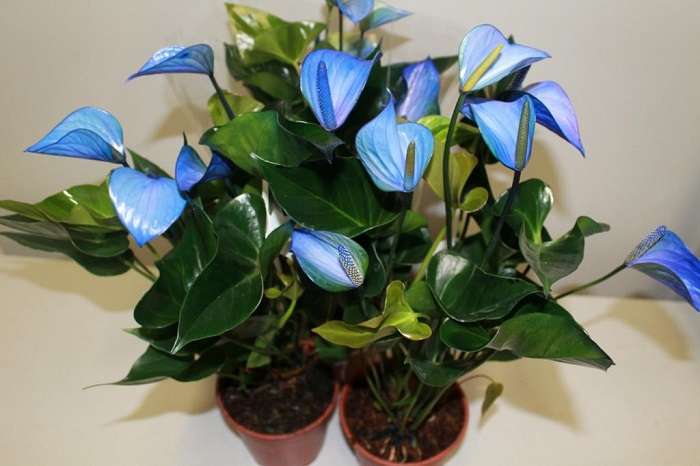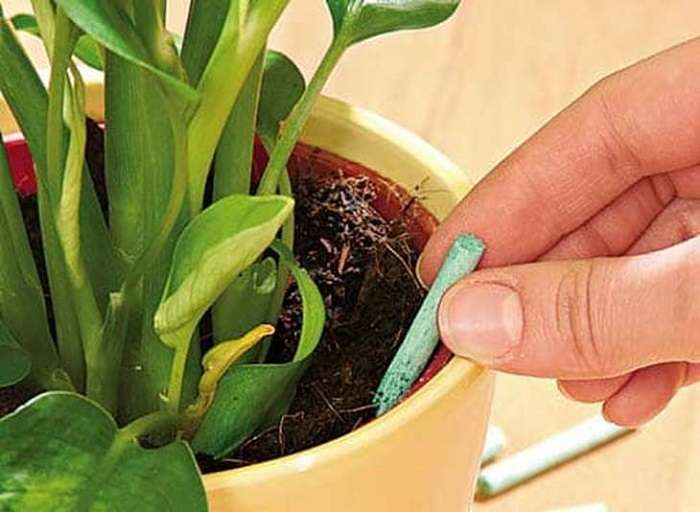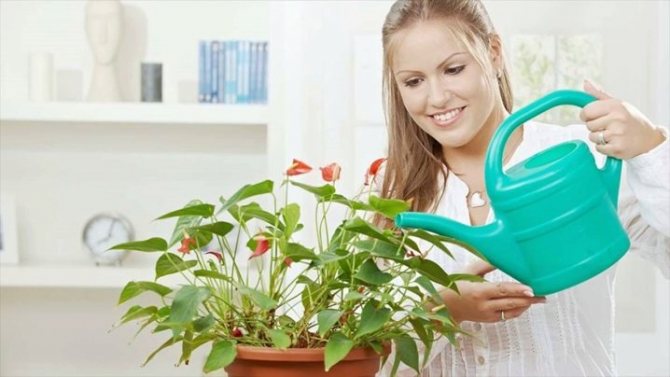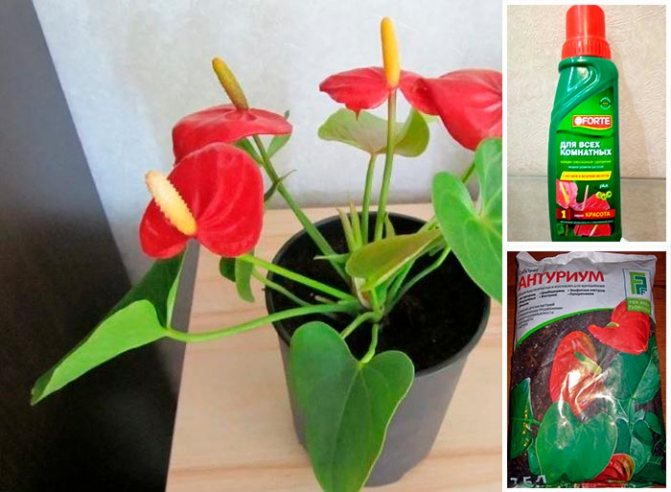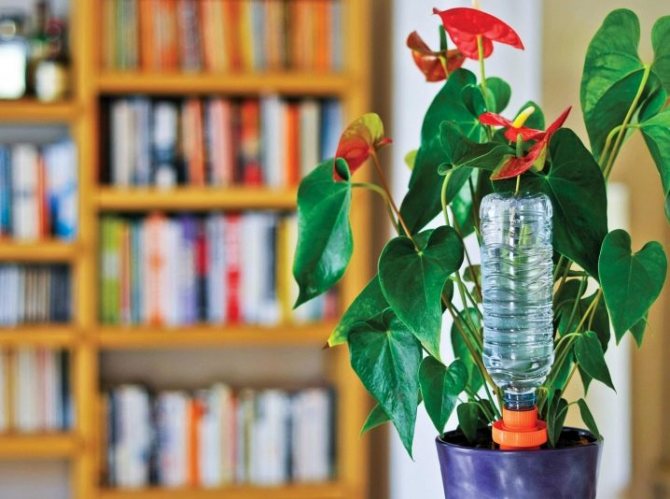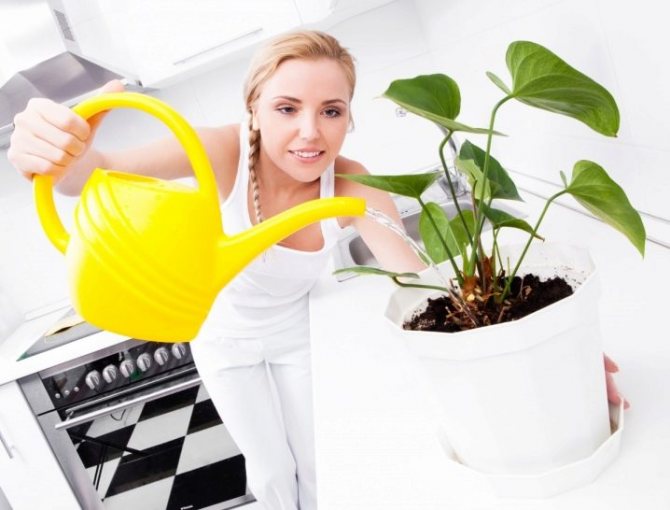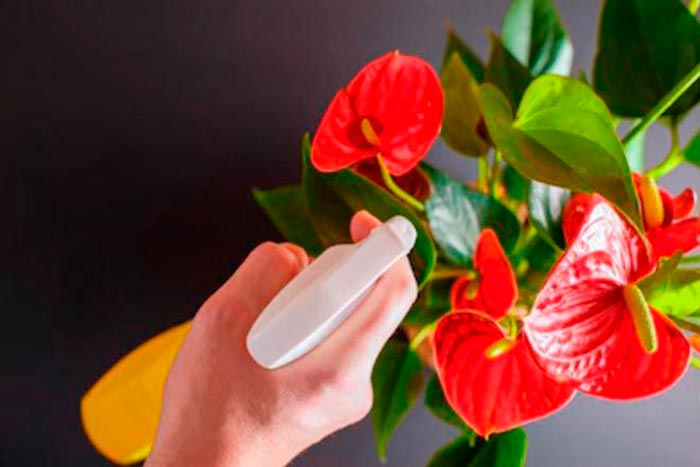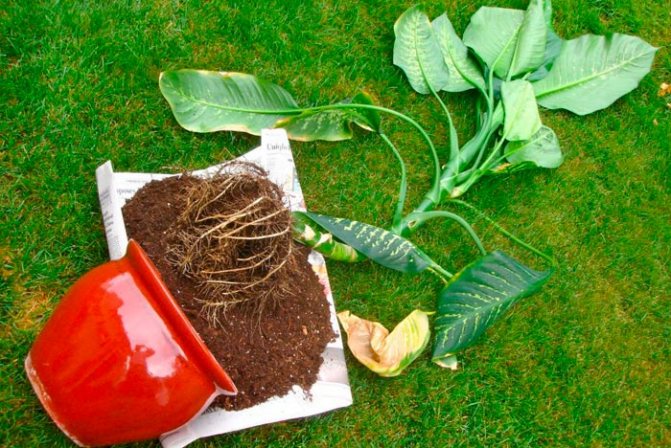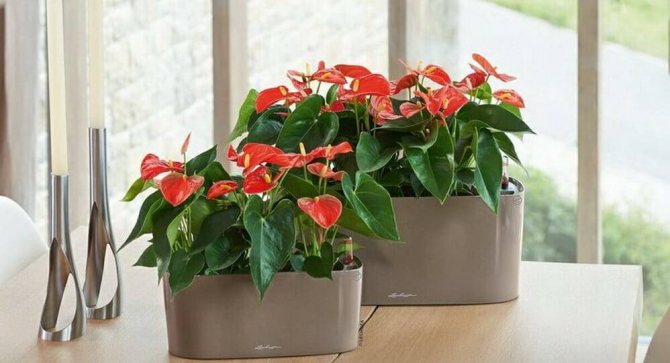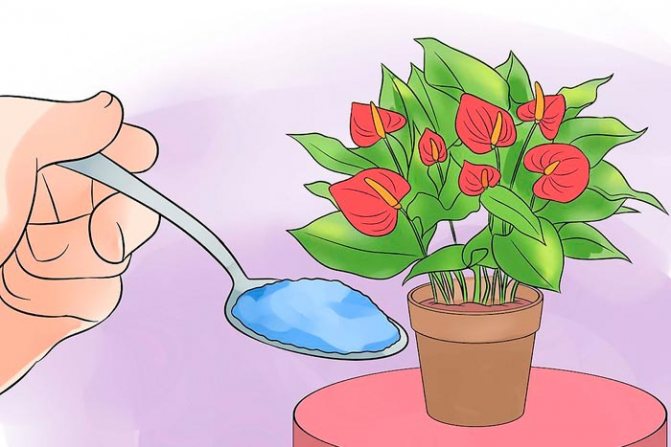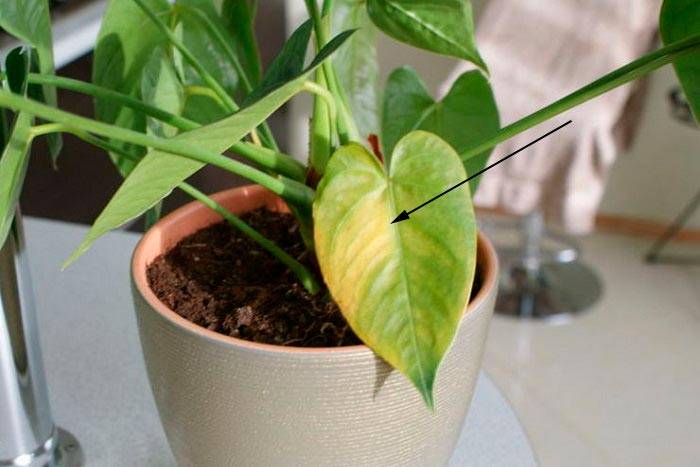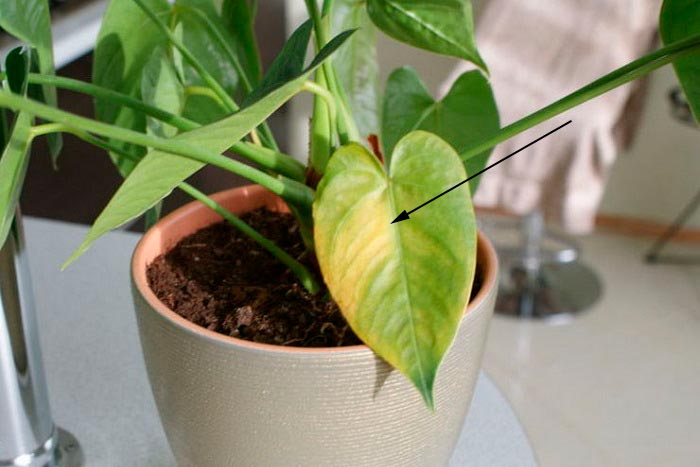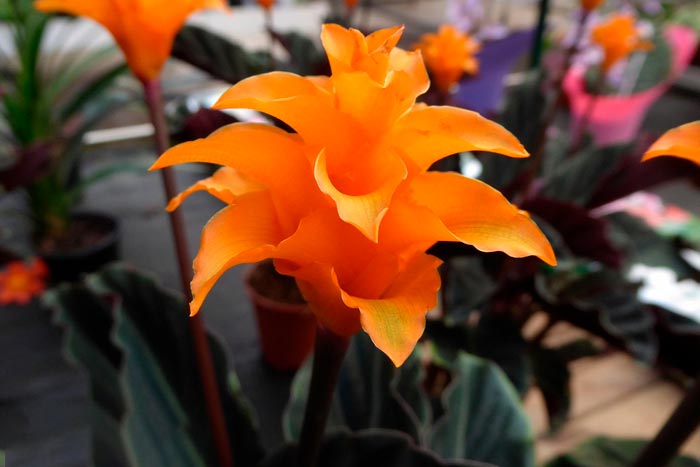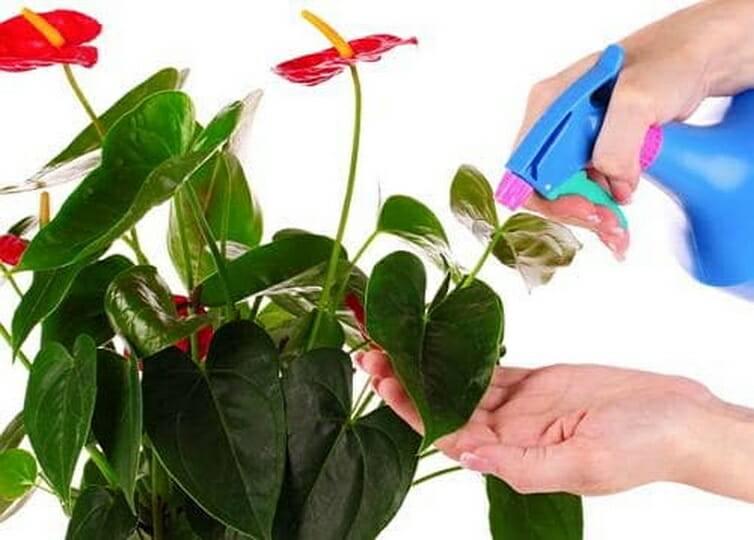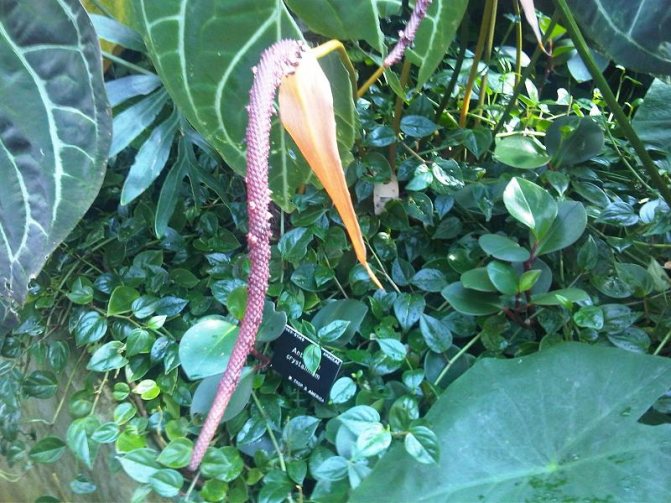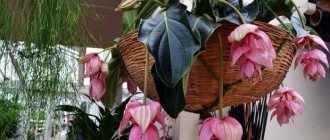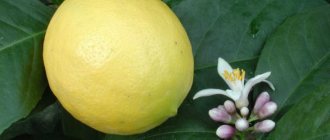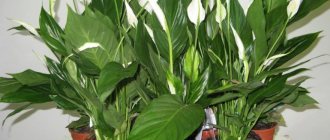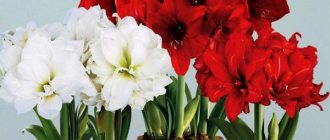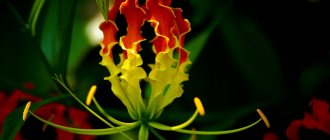At first glance, anthurium is somewhat demanding in care, although not enough to refuse it. It is better to understand your plant and try to provide the anthurium with the necessary home care.
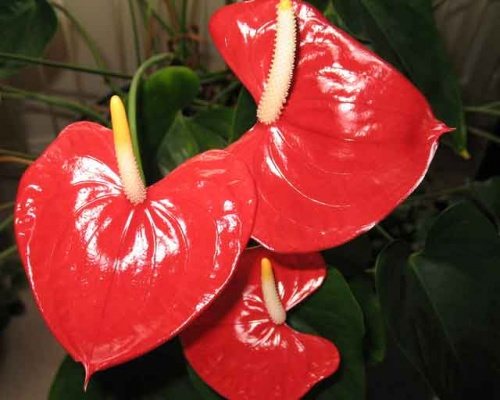
How to properly care for an anthurium and what will be required for its development and flowering? At home, in particular, two flowering species of anthuriums are grown: Andre (A. andreanum) and Scherzer (A. scherzerianum).
The vast majority of cultivated forms of anthurium are epiphytes. Many are well kept in warm, humid greenhouses.
Anthurium lighting
Anthurium does not tolerate both excess light and lack of lighting. The flower loves bright enough, but diffused light.
It is best to place this plant near windows facing west and east.
When placed near south-facing windows, the plant will be adversely affected by excess direct sunlight. In this case, the plant should be moved away from the window into the interior of the room, where it should be placed on a stand. You can also shade the windows with paper or other translucent material that diffuses direct sunlight.
In the northern part of the premises, anthuriums grow poorly due to lack of lighting.
Signs of Anthurium Nutritional Deficiency
Anthurium is a poisonous plant. Its juice irritates the skin, so it should not be allowed to get on the mucous membranes.
Nitrogen is responsible for the state of the foliage. If it changes color to yellowish and / or crumbles, then this indicates a lack of the element. Another indication of a lack of nitrogen can be:
- underdevelopment of buds;
- shrinking flowers;
- reduced flowering frequency;
- thinning and hardening of the stems.
Phosphorus deficiency is determined by slowing or stopping growth. In this case, the leaves of the anthurium curl and acquire a purple hue.
The appearance of brown spots on the leaves indicates a lack of potassium. If the deficiency of the element increases, foliage will begin to die off and crumble. A lack of potassium reduces the plant's immunity: it will suffer from fungal infections and pest attacks.
The normal growth of the root system depends on the presence of calcium in the soil. If the growth of the bush has slowed down, and the leaves are discolored at the very stem, then this indicates the need to add calcium-containing substances as top dressing.
From a deficiency of iron and copper leaves turn pale, especially young ones.
If the sheets become smaller and light spots appear on them, this is a lack of zinc. Lack of manganese affects photosynthesis, which causes pale spots on the leaves.
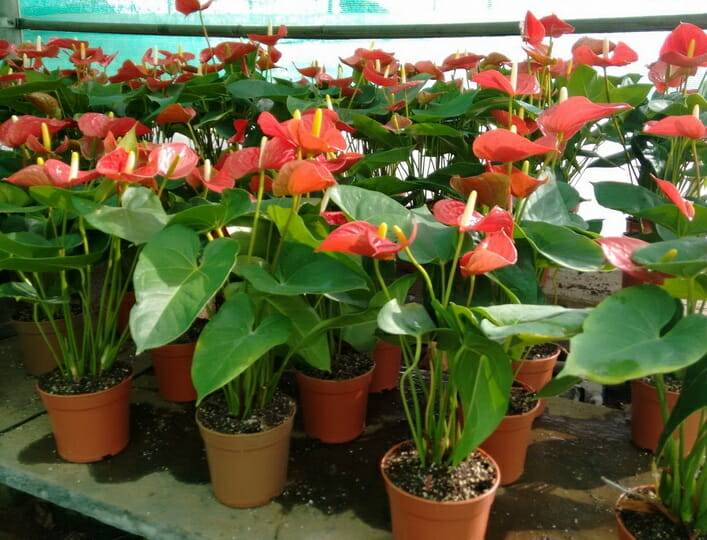

General description of the plant and types of anthurium
Anthurium has a positive attitude towards spraying from a spray bottle. Moisten not only the flower, but also the air around it, especially in winter. Carry out these procedures every 1-2 weeks.
Anthurium is an evergreen plant. Basically, the varieties are semi-epiphytes and epiphytes. It is characterized by a short stem and aerial roots. Leathery leaves vary in size and come in whole or with cuts along the edges.
The leaves are painted in a rich green hue and are often velvety. Some species are distinguished by variegated leaves. The flowers form large, cylindrical or cob-shaped inflorescences. The ear "hugs" the leaf, which has a greenish tint. The flowers are transformed into vibrant fruits with seeds.There are about nine hundred species of anthurium.
Anthurium red is characterized by beautiful deep red colors. The bract-cover "hugs" a yellowish or snow-white ear with a pleasant smell.
Scherzer naturally grows in Costa Rica. Indoors it takes root better than other species. Leathery leaves are combined with a yellowish cob, twisted in a spiral, and bright orange berries.
Majestic adapts well to the conditions of the apartment. The petiole is characterized by pointed edges. The leaves are distinguished by noticeable olive-colored veins.
André is a plant with large leaves of a rich green color, taking the shape of a heart. It can grow up to thirty centimeters in height. Peduncles are long, the veil is painted in a bright red color, sometimes it is bubbly. Also this variety can be called Andrianum.
Timing and frequency of application
Anthurium needs to be fed throughout the year. In the spring-summer period, as well as at the beginning of autumn, fertilizers must be applied every 2 weeks.
In winter, anthurium is at rest, but it must be fertilized at this time as well. In the second half of autumn and winter, the plant should be fed no more than 1 time per month.
Attention! It is especially important to observe the timing of fertilization for young plants. For the first six months, anthurium should be fertilized every 2 weeks, regardless of the season.
Fertilizers should only be applied when the plant is completely healthy. In the presence of pests, you must first get rid of them and only then carry out top dressing.
Homemade anthurium: how to care so that it is always pleasing to the eye (28 photos)
Anthurium is a tropical plant, but it will not tolerate drought. If you overdo it with watering, it will also harm the flower, as it will lead to the spread of mold.
To moisturize the plant, growers use bottom watering in the pan. For anthurium, this is not the most successful way, since it has air roots on the lower part of the stem. They also need to get moisture. For this reason, it is better to overlay the base of the plant with sphagnum moss. It retains moisture well and nourishes the roots. You can also use a mixed type of flooring, in which water is poured directly into the soil and topped up in the sump.
Important! When watering from above, the water should not penetrate the leaves and flowers. This will destroy the beauty of the plant's appearance, and the droplets, when dried, leave unsightly marks.
Water the anthurium 2-3 times a week, and after half an hour after moistening, pour out the excess liquid from the pan, otherwise the root system will rot.
The plant is sensitive to water, or rather to its temperature. It is forbidden to use cold water for irrigation. The liquid should be warm, at room temperature.
Do not moisten the flower with tap water, as this will negatively affect it. It is best to fill the bottles with water beforehand and then keep them at room temperature for 3-4 days. After this time, the liquid is ready for use. Also, you can not use hard water, and to soften it, you need to add lemon juice or citric acid. Table vinegar is also suitable: 10 drops per 1 liter of water.
In the tropics, anthurium varieties are plentiful. For cultivation in a cultural environment, several are selected, differing in color and shape of the inflorescence, color of the bedspread, configuration of leaves. Mostly in apartments you can find red anthurium with a bright yellow pistil. Burgundy, white, light purple, pink shades of the bedspread are also popular.
When the indoor anthurium flower throws out the first flower arrows for a novice florist, their appearance is surprising - the buds turn out to be green. Only when they are pouring, they change color to the appropriate type and variety. Its intensity depends on the illumination: the brighter the light, the richer the color.
Lack of light is undesirable for the plant - it blooms worse, the shape of the leaves changes. But the direct rays of the sun are simply detrimental to flowers and leaves. Therefore, it is best to place the pots on windows facing southwest or southeast. If this is not possible, remove the flower from the windowsill or shade it during the sunniest hours.
What are the other growing conditions? The ideal temperature is within 20 degrees. At 15 and below, the flower will die from hypothermia, at temperatures exceeding 30 degrees - from the heat.
If the indoor anthurium flower has large decorative leaves, it is advisable to install a support and tie up the stems to prevent them from falling. The aerial roots of the flower also require attention: they must be periodically sprayed and sprinkled with earth.
A flower purchased in a store requires a transplant after two years. How to transplant anthurium correctly? Stock up on a pot that is the right size. It should be wider than the previous one, but not by much, a maximum of two centimeters, so that all the energy of the plant does not go into the formation of new roots, and the flower shoots are deprived of it. Even very careful care in this case will not help: the plant will be alive, vigorously growing, but you may find that the anthurium does not bloom or blooms a little.
The lump with the plant is transferred to a new container, at the bottom of which there is a layer of expanded clay for drainage, and the free space is filled with fresh soil. The importance of drainage can hardly be overestimated - it protects plant roots from waterlogging and, therefore, from fungal diseases. When transplanting, anthurium is usually seated.
The soil is needed, intended specifically for aroid plants, or universal floral. If you use garden soil, do not take black earth or clay - the anthurium houseplant requires light, well-aerated soil. It should contain a lot of peat, some sawdust, chips, moss.
Having transferred the flower to a new dish and filling the free space with earth, compact the soil well.
The transplant time is usual, at which it is recommended to transplant any flower - spring. Within a month after the procedure, provide the flower with gentle conditions: water sparingly, do not fertilize, do not place in direct sunlight.
Having strengthened, the anthurium will turn into a blooming miracle and will present it with periodically ejected flower arrows for several months. And so that the flowering is almost continuous, take proper care of it.
Again, this flower is tropical in origin, which means it needs warmth and high humidity. However, anthurium, of course, loves watering, but you cannot overdo it with it. This can lead to mold growth in the soil that threatens the health of the plant.
In winter, anthurium is watered once a week, in summer - at least two. However, keep an eye on the condition of the earthen coma - it should not dry out at any time of the year. Another prerequisite for a flower is sufficient moisture. Too dry air, which is often found in urban apartments, is very undesirable for a migrant genetically predisposed to a humid tropical climate.
Take care of its moisture - spray the leaves. Avoid getting water on the flowers - this can provoke the appearance of ugly spots on them. Water for irrigation and spraying should be free of chlorine. Plumbing requires settling or passing through a household filter. You can water at the root or through the pallet.
During the period when the plant is not blooming, you can arrange a shower for it: water the leaves on both sides from a shower head under sufficient pressure and hot water (tolerable for hands). This will clean the plant not only of dust, but also of possible pests. In the summer, you can even take out anthurium in the rain, it will delight him.Of course, if the weather is calm and the rain is warm.
Anthurium at home for successful cultivation, flowering and reproduction requires periodic feeding. Top dressing can be in the form:
- granules;
- tablets;
- powder;
- capsules;
- cones;
- compressed cylinders;
- liquids;
The first top dressing can be applied already at planting. For this, a fertilizer with a prolonged action is chosen: tablets, capsules, cylinders. Their action lasts the entire season.
The downside is that they do not go to the roots immediately, and when the dormant period comes for the plant, they can no longer be removed from the soil. Liquid fertilizers act instantly and for a short time. Making them is convenient, usually combined with watering. In the summer, as a rule, they make a universal top dressing for flowering plants, in the winter they fertilize with humate. It is not worth overfeeding the flower, therefore it is better to take a reduced dose of fertilizer for application than is recommended by the manufacturer.
Anthurium can be propagated during transplantation. This is done in several ways:
- division;
- cuttings;
- aerial roots.
When a plant is transplanted, stems with roots are separated from the general massif and immediately rooted in prepared containers with suitable soil. This is the division of the bush.
To propagate a flower by cuttings, you need to cut off the top of the stem and place it in a peat substrate for rooting.
Aerial roots of anthurium deciduous forms can be rooted by placing them in a nutrient mixture. After a while, young sprouts will grow out of them.
How else does anthurium multiply? Seeds, but this method is only useful for breeders to develop new varieties and hybrids.
Anthurium diseases
Non-communicable diseases are common in all flower crops. Anthurium is no exception. The leaves of the plant turn yellow not because autumn has come and the time of leaf fall is approaching: this flower in nature is an evergreen plant. We are looking for the cause of leaf disease in violations of pet maintenance.
This may be incorrect watering: too sparse, hard or very cold water. Perhaps he lacks nitrogen fertilization. Or, on the contrary, the excess of fertilizers affected. Anthurium dries from lack of light. And if there is a lot of light, the leaves are likely to lighten and turn yellow. Leaves are also affected by exposure to stressful temperatures for anthurium: heat burns or frostbite from touching cold winter glass. Eliminate these shortcomings, and the plants you have grown will again delight you with a flowering look.
We have given you basic information on how to grow anthurium, how to care for it and how to make it bloom at home. If these recommendations are followed, any novice florist will grow on his windowsill this magnificent flower-tail (as the name is translated from Greek), a flower-flamingo or a flower "male happiness". Blooming anthurium at home creates a surprisingly cozy atmosphere.
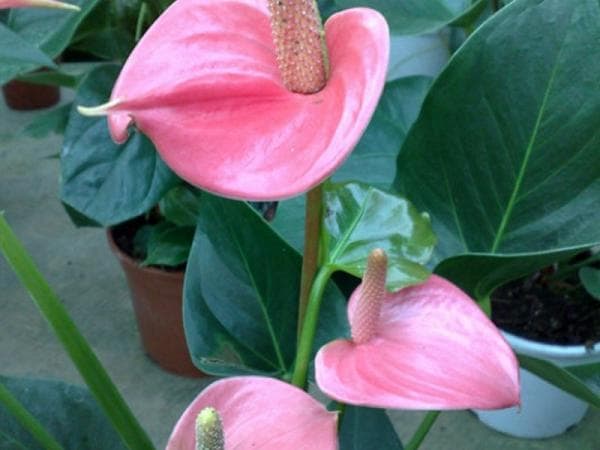

Indoor anthurium is a bright and unusual plant. In addition to decorative, it performs an extremely important practical function - it cleans the air in the room and improves its microclimate. Let's deal with the rules and features of caring for an exotic handsome anthurium.
Pot selection
Anthurium transplant is a rather drastic intervention in the usual life of the plant. That is why, after the purchase, give the "tropical handsome" the opportunity to get used to the new conditions. Usually exotics acclimatization takes no more than 5-7 days. This time you can start selecting a new planting capacity and preparing the substrate. Since the root system of the plant is superficial, a rather wide, but shallow plastic pot is chosen for transplanting.
If you take proper care of the anthurium flower, then even in difficult cases, you can make it bloom.What tricks do you need to do for this? To do this, you must comply with the conditions described below: grow a flower on a ready-made soil composition or feed it with certain fertilizers, then the atrium will look bright like a flamingo.
A diffused light is needed that does not include the sultry direct rays of the sun. For this reason, east or west windows are ideal for home use.
Watering needs
Anthurium is a tropical plant. A native of humid and hot tropical and subtropical forests, it does not tolerate dry air and a lack of moisture in the soil. However, abundant overflow is also harmful, since it provokes rotting of the root system of the flower. How often to water anthurium - 2-3 times a week or month - depends on the type of plant, the period of its development, the season, as well as the temperature and amount of light in the room. Usually a flower signals a lack of water:
- a decrease in leaf turgor;
- a change in their color and color of the bracts;
- by changing the angle of inclination of the leaves - it becomes less than 45 °.
Abundant rare watering is much more harmful to the health of the plant than drought, even quite prolonged. Waterlogging of anthurium is dangerous, first of all, by the development of fungal diseases. The fact that the flower suffers from excess moisture is evidenced by:
- slowdown in growth;
- the appearance of mold on the trunk and leaves, the formation of brown spots on them;
- unpleasant smell from the pot;
- decay of roots.
Prevention of moisture stagnation in anthurium is the use of drainage and pots with large holes in the bottom.
When transplanting, the soil is moistened as much as possible, therefore, after the "relocation", you should not water the flower for several days (sometimes a week). If, due to decay, it was necessary to remove part of the root system, the new substrate is not first watered, but the drainage is saturated with water, pouring liquid into the pan.
If the self-made soil mixture for anthurium is too dense, the amount of watering is reduced to 70% of the usual.
Indoor humidity
Anthurium loves moisture. Therefore, water the plant regularly, avoiding the drying out of the earthy coma in its pot.
In winter, when the air is dried by central heating batteries, it is imperative to spray the leaves from any spray bottle, wipe them with a damp cloth and try to maintain the relative humidity in the room close to 60%.
To do this, you can get an air humidifier, which is also recommended for people with respiratory problems.
If you don't have a humidifier, you can put a large aquarium in the room. Water evaporating from the aquarium will naturally maintain normal humidity in the room.
Spraying
Anthurium belongs to subtropical exotics, therefore, it responds with gratitude to spraying. For this procedure, various kinds of hand-held spray guns are used. Spraying allows you to moisturize not only the plant itself, but also the air around it. This is of particular importance during the heating season, when the air humidity drops significantly. The procedure must be performed at least once a week.
And also florists recommend spraying anthurium from time to time, as well as watering it under the root with succinic acid, diluted in the following proportion: 1 tablet of acid per 5 liters of water. This event will significantly improve the health of the root system and the aboveground part of the plant.


Top dressing
You need to feed the plant in spring and summer during the period of active growth of the plant every two weeks.
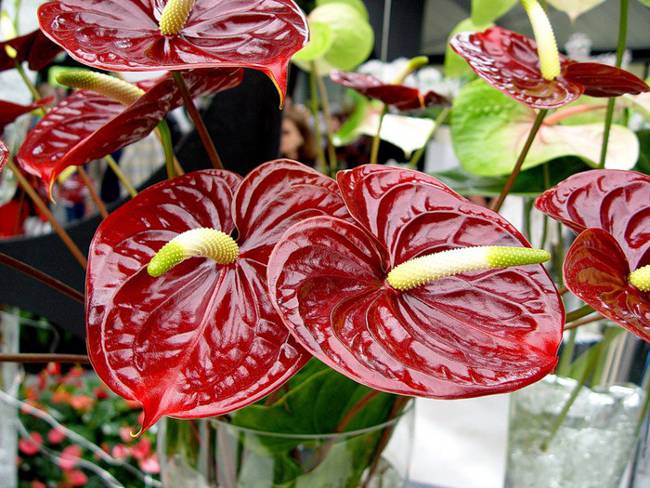

The concentration of fertilizing should be half that indicated on the label of the mineral fertilizer purchased for fertilizing.
Good feeding comes from chicken droppings. Its infusion in small quantities must be periodically added to the soil to give the plant a beautiful healthy look.
After starting the application of top dressing, take a close look at the plant - does the anthurium normally perceive the selected fertilizer. If the dressing is "to your taste" and the plant looks beautiful and healthy, you should not change it. Use the selected top dressing throughout the next years of the plant's life.
In some cases, foliar feeding may also be required.
During the period of active growth and development, anthurium must be fed twice a month using mineral and organic fertilizers. In March and April, it is advised to purchase fertilizers for decorative leafy plants, and from May to September - for decorative flowering plants.
To maintain weak flowers, foliar dressings are used. Chicken manure infusion can be used as organic fertilizers.
Fertilizer at home
The "home" fertilizers used for feeding anthurium include:
- Dry yeast solution. Contains a large amount of vitamins and minerals. Preparation of the solution involves dissolving ½ teaspoon of dry yeast and 2 tablespoons of sugar in 5 liters of warm water. The mixture must be left for 1 day, then diluted with water in a ratio of 1: 5 and water the anthurium at the root.
- Sleep coffee and tea brewing. It is applied at the root no more than 2 times a month.
- Citrus infusion. The peel of the fruit should be crushed, filled with water and left for several days, after which it should be used for watering the plant.
- Natural ash solution. To prepare it, you will need 1 tablespoon of ash and 1 liter of water. Plants should be watered 2 times a month.
- Onion peel decoction. The recipe provides for pouring 50 g of husk with 2 glasses of hot water. Then the mixture must be boiled for 10-15 minutes, then let it brew for 3-4 hours. The resulting broth should be filtered and used for watering the anthurium.
How to water anthurium?
Despite the fact that the plant loves moisture very much, it should not be poured in order to prevent the roots from rotting.
The pot with the plant should be placed on a pallet where water can drain from the pot after watering. It is advisable to remove this water from the sump in a timely manner so that the lower part of the soil layer in the pot does not stand constantly watered and does not turn into a musty swamp.
Watering should be done when the soil in the pot dries out by about a third of its volume.
Frequent watering can weaken the plant and lead to various diseases. Including spider mite disease.
For irrigation, use soft, settled water at room temperature. When watering with hard water, the tips of the leaves may turn black.
Humidity is an important factor in caring for anthurium ...
Be sure to pay attention to the quality of irrigation, the water should be soft and warm, well settled. Water sparingly as soon as the soil dries up. For healthy anthuriums, it should always look slightly damp, but if you dry it a little, it's okay.
Very often, the opinions of florists differ regarding the humidity of the air.
- Some believe that the flower must be sprayed every day.
- Others are satisfied with wiping the leaves with a damp cloth.
- Still others increase the humidity of the air by placing a flower pot on a pallet with wet moss, expanded clay or covering the base of the plant with sphagnum, constantly moistening it.
However, when using any of these methods, you need to adjust the room temperature depending on the general condition of the plant. Spray and create moisture around the anthurium at a temperature of at least 20 degrees.
High humidity at a low temperature of 16-18C will lead to infection of the flower with fungal diseases. Low humidity at the same temperature will reduce resistance to various pests: scale insects, spider mites, aphids. Therefore, in the event of any critical situations, it is better to replace ordinary spraying with wet wiping of the leaves.
Overcooling of the root system should be avoided, watering should be done only with warm and soft water. Try not to create excessive moisture, otherwise a fungus will appear on the soil.
To maintain the purity of the leaves, it will not be superfluous to arrange a warm shower for the anthurium every week. It is recommended to cover the substrate with a plastic bag. After the leaves are completely dry, put them back in place.
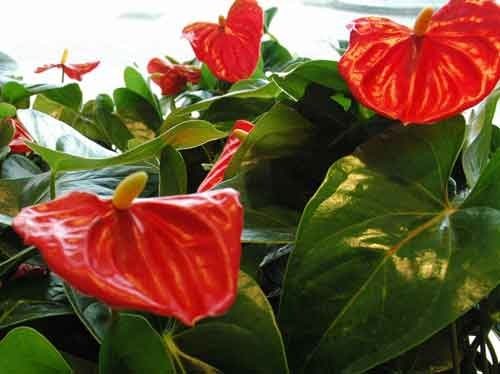

Blooming Anthurium is a dream come true if you know what the care should be.
Pot and soil selection
The soil is prepared independently or purchased in stores, choosing the soil for aroids. The mixture is prepared from leafy earth, humus, peat and sand in a ratio of 1: 2: 1: 0.5. Cones, moss, broken brick or charcoal are added to the ground. These components are required to give the mixture good water and air permeability.
Impurities make up ten to fifteen percent of the total amount of soil. Anthurium prefers slightly acidic soils with a pH of 5.5 - 6.5.
It is important to choose the right pot for the anthurium. The plant is planted in a wide and flat container. In a too large and free bowl, he will not dissolve flowers, and in a small one he will let out roots.
When choosing a pot, a general rule is followed: each new container should be two centimeters larger in diameter than the previous one.
What to look for when buying, price in Moscow and St. Petersburg
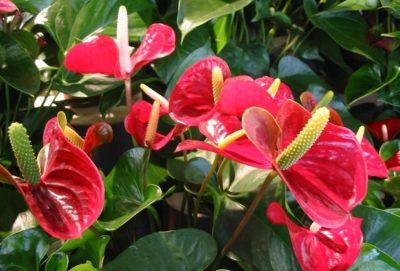

Quite a lot of ready-made plant food is sold, but the most famous of them, as mentioned earlier, are Azalea, Kemira Lux and Uniflor Buton.
When buying a fertilizer, you should pay attention to ease of use, purpose, pricing policy. There are many forms of fertilizer for different parts of the plant., so when purchasing it is worth thinking about what exactly you are choosing it for.
In Moscow and St. Petersburg, prices for good fertilizers range from 150 rubles to 700 rubles.
How to transplant
Young specimens are transplanted every two years, and adult plants are transplanted every three years. A high-quality drainage from expanded clay or other material is laid at the bottom of the pot. A layer of sphagnum moss or coconut fiber is placed on top of the drain.
The next layer already consists of a specially prepared mixture. Anthurium is taken out of the old pot along with an earthen lump. To make the process easier, the earth is moistened. As far as possible, the earthen lump is shaken off the old soil and placed in a new container. The resulting voids between the walls of the pot and the earthy clod are filled with earth.
Factors affecting the frequency and abundance of watering
The irrigation schedule and its strength are dependent from the following external factors:
- Pot material. Anthuriums planted in clay pots always ask for more water, which is explained by the physical properties of clay, which perfectly permits moisture through itself and allows it to evaporate from the outer surface of the pot. Anthuriums planted in plastic need less water when watering.
- Plant age. If the anthurium is young, then the top layer of soil in the pot should always be moistened. An adult plant is comfortable in drier soil.
- Development period. During flowering and activation of growth, anthurium needs a lot of moisture. At the same time, during the dormant period, it is an indication to reduce the volume of irrigation by 2 times.
- Substrate composition. If the anthurium is planted in a moss substrate, then watering must be done as it dries. At home, the dryness of the moss can be determined by lightly rubbing it with your fingers and hearing a slight crackle. And also due to lack of moisture, the moss begins to turn yellow. At the same time, it is not worth pouring moss, since there is a danger of rotting the root system of the plant.
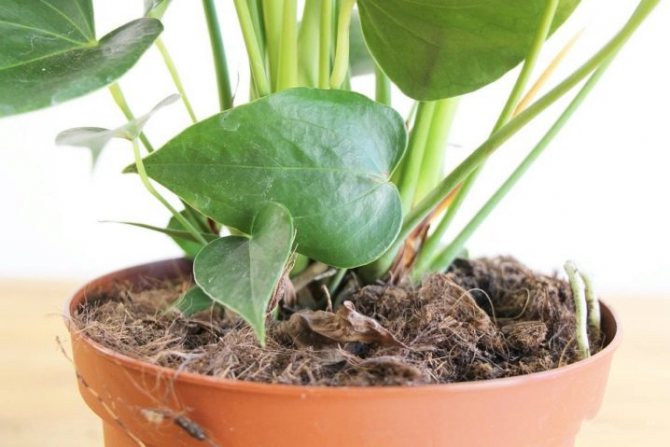

Rejuvenation
Anthuriums that have reached a certain age lose their decorative qualities. The leaves below die and expose the trunk. Flowering becomes shallow, and sometimes completely stops. What to do with such an over-aged specimen? It should be rejuvenated. This process is carried out during transplantation.
There are three ways:
- root the apical stalk. The top of the plant is wrapped in moss and waited until the roots grow. Then the cutting is separated and planted in a pot.
- the apical stalk is simply cut off along with the aerial roots and planted in a container, without deepening the outlet, but placing the roots in the ground;
- you can grow the roots of the cuttings in water by placing it in a container with liquid. This method has a serious drawback: the sprout can rot in a humid environment.
Mature plants are given a youthful and healthy shine with a leaf polishing procedure. Large leaves of anthurium are treated with special liquid or aerosol polishes sold in special stores. There is a wide range of similar products on the market.
Such funds are used strictly following the instructions. Leaves are sprayed or wiped by hand.
General tips for growing anthurium
With good care, anthurium blooms all year round, delighting the grower with large leaves and a lushly overgrown bush. It is necessary to start caring for the culture with planting, in which the main condition is the choice of the substrate. It can be prepared according to this recipe: take one part of sod land and coarse sand, two parts of humus mixed with pieces of charcoal. The disadvantage of this soil in the service life: it is no more than a year, then it should be changed. Soil with high acidity is suitable for azaleas, diluted with peat.
You can use ready-made orchid primers. The main thing is that the substrate is light, allows water and air to pass through, but can hold the bush.
Self-made soil must be thermally treated or disinfected using special means.
To achieve lush flowering, the plant must be planted in a cramped pot, which the root system will completely braid. The material of the container must have a solid inner surface into which roots cannot grow. Expanded clay is best suited as drainage.
In order for the anthurium to bloom, it needs good illumination, but direct sun is contraindicated in the daytime. The plant will feel comfortable on the western and eastern sides, and in the northern part of the house and in the shade it can completely degenerate.
The mistake of many gardeners is too abundant watering. Moisten the soil as it dries.
The air humidity in the room where the anthurium grows should be high. To create such conditions, you need to spray the leaves every day and irrigate the culture with a warm shower once a month. There is another way - to place a container with a flower on wet expanded clay.
Anthurium attracts spider mites, aphids and scale insects. Garlic will help scare them away if you spread it peeled around the trunk, and treat the foliage with soapy water. A common anthurium disease is anthracnose. It manifests itself in the form of drying out of the edges of the leaves. It is important not to miss the first signs and start treating with fungicides (the most effective is Fundazol).
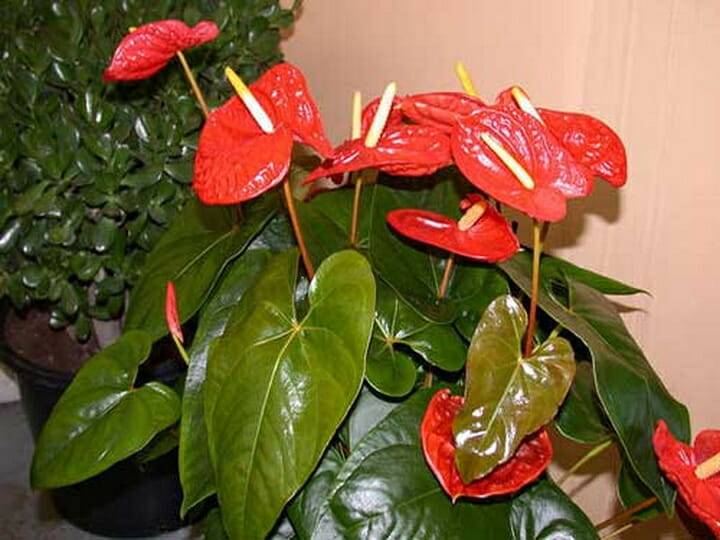

Conditions for ensuring year-round flowering:
- The temperature in the room should not drop below +18 ° C.
- Good lighting out of direct sunlight.
- Sufficient pot volume.
- Correctly selected soil composition.
- Regular, but not over-watering.
- Humidified air.
- Elimination of drafts.
- Competent fertilization.
Especially pleasing to flower growers anthurium is that it can be propagated in various ways. A new plant is obtained:
- simple division of the bush;
- lateral processes;
- upper shoots;
- leaf petiole;
- a piece of stem with aerial roots;
- seeds.
All methods of reproduction, except for the last one, retain the properties of the mother plant.
Thus, anthurium is not too picky: it can grow without fertilizing, but the plant can show itself in all its glory only by receiving a sufficient amount of nutrients.
How to transplant anthurium?
Like other plants, anthurium grows throughout its life, the size of the root system increases and the former "dwelling" becomes cramped for it. Therefore, before the age of 5 years, anthurium should be transplanted annually in the spring from February to March in a larger pot.
The diameter of the new pot should be 2-3 cm larger than the previous one. This will allow the plant roots that have grown over the year to accommodate with sufficient comfort.
After the anthurium reaches the age of 5 years, it can be transplanted less often - once every 2-3 years.
When transplanting, it is advisable to remove faded inflorescences.
The transplant soil is also prepared on the basis of deciduous soil, peat and coarse sand.
Anthurium
Anthurium has very beautiful plastic flowers of various shades, inside which there is an inflorescence-cob of yellowish, reddish or greenish color. Leaves are cordate, spatulate or rounded. In some species, they are dissected. The surface of the leaves is matte or glossy. Depending on the species, the height of the plant ranges from 40 to 90 cm.
With proper care, anthurium blooms all year round. To do this, he needs to create conditions as close as possible to the natural environment. Anthurium should receive a sufficient amount of light, therefore, in the warm season, in the morning, it is recommended to expose it outside the window. In addition, the flower needs regular watering and fertilization. The last event is especially important for year-round flowering.
Reproduction
Anthurium propagates by cuttings and seeds.
To propagate a plant using a cutting, you should separate one or more stem shoots and transplant them into a pot of sandy soil, covered with a transparent glass jar of a suitable size and periodically moistening the sand.
Anthurium can also be propagated using plant seeds.
The seeds are washed with a weak solution of potassium permanganate and sown on a substrate with a small layer of perlite, the seeds are slightly pressed into the substrate and covered with a film for several weeks.
After the shoots appear, they need to be dived and transplanted into a substrate from a mixture of charcoal and leafy earth with the addition of peat.
To get the seeds of a plant on your own, you should carefully transfer pollen from one flower to another with a cotton swab during the flowering period and wait until the fruit is tied. When the fruit is ripe, it must be carefully separated from the plant, the seeds removed and planted as described above.
When keeping anthurium, do not forget that all species of this plant are very poisonous and can cause severe poisoning in both humans and animals.
Anthurium reproduces in several ways: by dividing the stem, cuttings, aerial roots and seeds.
Division of the stem
A young sprout with a root system is separated from the mother plant and planted in a separate container, applying all the rules for choosing soil, pot and replanting.
Cuttings
The tops of the stems are cut off as cuttings. They are planted in small containers and greenhouse conditions are created, covered with a jar or bag. Reproduction takes place in a similar way with the help of aerial roots, the root is carefully separated and placed in greenhouse conditions, where a new anthurium will develop in a few months.
Seeds
Seed propagation is the most difficult. In order for a fruit to set on the anthurium, artificial pollination is performed. Using a cotton swab, the pollen is transferred from one flower to another.
After a year, fruits will ripen on the plant, from which seeds are extracted.They are treated with a solution of potassium permanganate and placed in the prepared soil, slightly pressing into the surface.
The pot is covered with foil to create a greenhouse effect. When the sprout appears with the first leaves, it is transplanted into a permanent container.
How to feed anthurium
When growing this crop at home, it is necessary to provide the plant with full care. After transplanting, the first 2-3 months, additional fertilization is not required if a nutrient substrate was used. After that, it is recommended to feed it with weakly concentrated solutions for the entire period of active growing season.
Fertilizers for flowers are produced in several forms:
- liquid;
- pills;
- granules;
- powder;
- compressed cylinders.
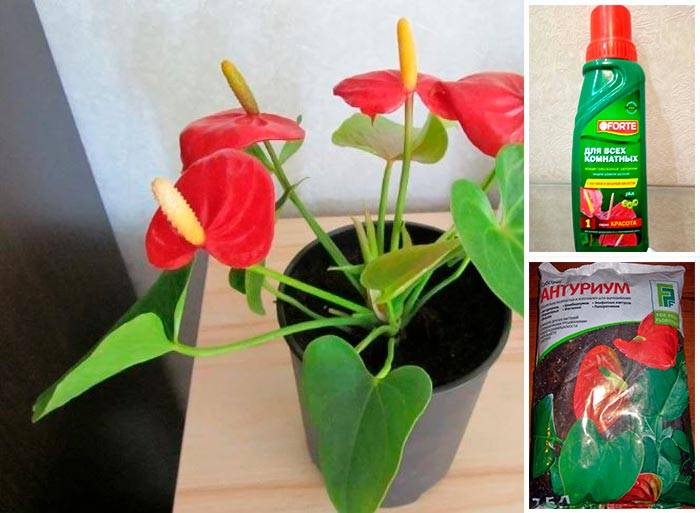

Granular preparations are designed for almost the entire season. In the spring, they are scattered over the soil surface and mixed with the top layer, shallowly embedded. Dry fertilizers can provide anthurium with nutrients for several months, which must be taken into account when choosing this method of feeding.
Other products are recommended for use in the form of solutions. Their action is short-lived, often lasting no more than 2 weeks. For this reason, the procedure with such drugs is carried out regularly. It is important to take into account the dosage recommended on the package; for anthurium it is desirable to reduce it up to 2 times.
There are remedies for folk recipes. Simplicity, efficiency and affordability are the main advantages of such anthurium dressings at home. The main disadvantage is that it is impossible to measure the exact concentration of nutrients supplied to the plant.
Choosing a fertilizer
The use of ready-made complexes for flowering indoor plants greatly simplifies feeding. Universal mixtures contain a sufficient amount of macro- and microelements, vitamins. Modern preparations additionally include humates. It is enough to dissolve such a remedy in boiled water and pour the flower with the resulting solution.
Fertilizers for anthurium:
- Fitosporin-M;
- Forte;
- Uniflor bud;
- Effecton for indoor plants;
- Yantarin, VRK;
- Kemira Lux.
Of the usual organic additives, mullein, bird droppings, rotted humus and wood ash are used. Substances have a high concentration of active nutrients and therefore require proper dilution.
To prepare a mullein solution, you should take 1 tbsp. l. or 1 tsp. bird droppings per 1 liter of water. Humus is added to the soil substrate when anthurium is transplanted. Moreover, it is permissible to use it no more than 1 time in 2 years. Wood ash is allowed to be brought in at planting or to prepare an infusion from it.
Folk recipes
The advantage of such tools is the efficiency and availability of raw materials, since they are found in many homes. Onion peels, tea leaves, coffee grounds, yeast tincture, citrus peel or banana peel are used as a source of nutrients. It is recommended to change top dressing with folk remedies with each other.
- For a decoction of onion peels, 50 g of dry matter are required, pour 2 tbsp. hot water. The mixture needs to be boiled for 10-15 minutes, after which it should be infused for 3-4 hours.
- Used tea leaves and dormant coffee can be spread over the surface of the soil substrate and slightly mixed with the ground.
- An infusion is prepared from the peel of citrus fruits and bananas.
- Dry yeast is a rich source of minerals and vitamins; for anthurium it is used as an infusion.
Growing a crop at home requires regular feeding. The procedure is not mandatory if the plant is periodically transplanted into a nutrient substrate, strictly observe the light, humidity and thermal conditions. At the same time, there is a risk of being left without flowering, which significantly increases the decorative qualities of anthurium.
Diseases and pests
Improper care provokes the development of diseases and the appearance of pests.Anthurium can be susceptible to the following diseases and parasite attacks:
- anthracnose. Symptoms: the stems and leaves are covered with brown spots, then the leaves turn brown and dry, the plant dies out. Control methods: the infected areas are removed, the anthurium is sprayed with Oxyhom or other fungicides;
- white rot. Symptoms: The lower leaves lose color and are affected by a white bloom. Control methods: use fungicides, for example "Oxyhom" and "Bordeaux mixture";
- spider mites, scale insects, thrips. Control methods: acaricides (Aktellik, Akarin) and insecticides (Aktara, Biotlin).
When do you need watering?
Lack of moisture by experienced growers is determined by the following criteria:
- the usually juicy color of the bracts becomes dull;
- leaves cease to be elastic and shiny, lose color;
- the ends of the leaf plate become dry and brownish spots appear;
- the angle of inclination of the leaves becomes less than 45 degrees;
- you can determine the lack of moisture by the weight of the pot.
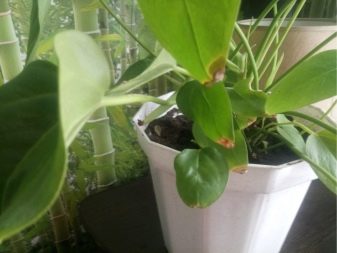

What is anthurium sick with?
The most common diseases that anthurium suffers from are stem rot, plant pox, fusarium wilting, enations.
When rot appears, the humidity in the room should be reduced and the plant should be sprayed with Saprol or Fitosporin-M.
When yellow pockmarks appear on the leaves of the plant, you need to cut off the diseased leaves, reduce the humidity and maintain the temperature at 18 degrees.
Fusarium wilting can be identified by the appearance of a characteristic pinkish bloom in the area of the root collar. The diseased plant begins to lose leaves, which turn yellow and wither. To combat this disease, it is recommended to thoroughly rinse the plant under the shower, remove the soil from the roots and transplant the anthurium into a new pot, preparing a new potting soil mixture in order to get rid of the pathogenic fungus.
In the case of constant drafts, changes in temperature or humidity, the leaves of the plant begin to take an ugly shape, look deformed, and grow unevenly. To restore the plant to its beauty and healthy appearance, all these unfavorable factors should be eliminated.
Signs of a lack of nutrition
The lack of a particular trace element can be determined by the appearance of the plant. With a lack of nitrogen, the leaves become small and turn yellowish. Some of them shrink and fall off. Buds develop poorly, and roots and shoots stop growing. Anthurium begins to bloom periodically, and the flowers become small and dull in appearance. The structure of the stems also changes. They harden and thin.
With a lack of phosphorus, growth and development slows down. Leaves curl, reddish-purple or brownish-purple spots appear on their surface. With an acute deficiency of phosphorus, anthurium may stop blooming.
Potassium deficiency is manifested by the formation of brown spots on the leaves. At the same time, their central part and the area on the sides of the veins remain green. A sharp potassium deficiency is manifested by the death of some leaves, followed by their fall. Anthurium immunity also suffers. The plant is poorly resistant to fungal diseases and is often affected by pests.
Calcium is needed for root growth. Its insufficient intake leads to a slowdown in plant growth. In addition, parts of the leaves near the base are discolored. They curl over time. Brown spots may appear on young leaves.
Lack of magnesium is manifested by blanching of the leaves and curling of their edges. The roots do not develop well and the plant looks weak and emaciated.
With a lack of iron and copper, the leaves turn pale, become almost white. First of all, young leaves suffer.
Zinc deficiency leads to a decrease in leaf size and the appearance of light spots between the veins. The root system of the anthurium also suffers. Roots develop poorly, and new roots are not formed at all.
With a lack of manganese, photosynthesis is disrupted, as a result of which yellowish and whitish spots appear on the leaves. The plant stops growing and blooming.
Blooming anthurium
The plant lays buds if it hibernates at a temperature of fifteen to sixteen degrees. Anthurium can delight with flowers throughout the summer. Some hybrids bloom all year round. One flower stays on the plant for a month - one and a half.
The flowering of anthurium is directly related to the observance of the necessary conditions of detention. A plant may refuse to bloom if it grows in a pot that is too large, if the lighting conditions, temperature, watering, humidity and other parameters of the content are not observed.
In order for the flower to bloom, you should adhere to the temperature regime in winter - no higher than twenty degrees.
The rest period, which lasts about two to three months and begins at the end of autumn, must be guaranteed, otherwise you can say goodbye to flowering. If the anthurium refuses to bloom flowers, you need to adjust the watering: you can not fill the plant and dry it out.
In both cases, there is no need to wait for flowering. If the pot for the plant is too large, the anthurium is transplanted. Do not forget about fertilizing and the soil that the plant needs. If you follow all the conditions of detention, the anthurium will definitely bloom again.
Anthurium is considered a complex plant, like any other flower, it requires sufficient attention of the grower.
Temperature control and lighting ...
For full-fledged growth and generous flowering, the anthurium is satisfied with conditions that are suitable for orchids: constant heat, bright lighting, but not direct sun, high humidity.
Room temperature close to natural in summer - 20-28C, in winter not lower than 16-18 ° C, away from heating appliances.
Scherzer anthurium hybrids require cooler maintenance (12-16 ° C) for two months in winter, while reducing watering. In order for the anthurium to bloom early, in January they begin to gradually increase the temperature to 20-25 ° C.
Since the plant tolerates drafts and temperature fluctuations very painfully, in a frosty winter it is better to place it not on the windowsill, but indoors, providing additional artificial lighting using phytolamps.
In low light, anthurium will not bloom, and if the light is too bright, its veil-bracts will become less saturated in color. Therefore, when caring for an anthurium flower, it is important to find the "golden mean".
Frequently asked Questions
From the moment of rooting, the flower needs a certain time for ripening and the appearance of inflorescences. Some anthuriums begin to bloom after a year. And some take at least 3-4 years.
In order for the plant to release a flower, it must be comfortable enough - a pot of the required volume, no drafts and bright direct sunlight, timely watering and feeding.
If small specks appear on the leaves, which are clearly visible in the light, most likely this is the result of the activity of a spider mite - an insect that often starts in domestic plants, leading to illness and even death, if timely measures are taken to get rid of the pest.
To get rid of the spider mite, you should carefully treat all the leaves and stems of the plant with soapy water, and then with mineral oil.
If the spots are large enough, then this may be the result of plant pox disease or deterioration in appearance due to drafts and improper lighting. It is advisable to cut off damaged leaves and try to bring the conditions of the plant in accordance with the recommendations described above.
How to choose the right substrate?
Anthurium planted in heavy soil will quickly lose its attractive appearance (leaves and flowers will become smaller), and it will also start to hurt.The commercially available universal aroid soil is heavy and the orchid mix is poor in nutrients.
The ideal soil should be loose, slightly acidic, nutritious, water-absorbing and well-permeable. You can prepare the composition yourself by mixing the soil for azaleas or begonias (two parts) with perlite, pine bark and sphagnum (one part at a time).
Some growers grow beautiful anthuriums hydroponically, planting them in a mixture of perlite with expanded clay, or in pure sphagnum. Such soils hold moisture well, ensure normal root respiration and maintain optimal moisture content.
When grown on a hydroponic system, in winter the plant must be kept at a temperature of 18C, supplemented with phytolamps, water for irrigation must be replaced with a solution for hydroponics twice a month.
Reproduction of anthurium
Division of adult specimens or separation of rooted side shoots. To do this, the bush taken out of the pot must be carefully cut with a knife, cut off the necessary part with a piece of rhizome. Try not to disturb the bulk of the roots. Sprinkle all large sections with crushed coal or sulfur (sold in pet supplies) to close the gate for infection. Water the planted parts carefully during the first week. Avoid splitting and replanting on the hottest summer days.
Seed reproduction is also possible. After cross-pollination (for this you must have two plants flowering at the same time), the seeds ripen within 8 weeks, after which they must be planted immediately, as they quickly lose their germination. The soil is light from a mixture of vermiculite and peat in equal parts. Vermiculite can be replaced with coarse sand. The soil can be covered with a thin layer of sphagnum moss, and seeds can be sown into it. Moisten the top evenly from a spray bottle, cover with foil. Ventilate regularly so that mold does not form on the surface of the ground.
Irrigation methods and water requirements
For anthurium, the most common method of watering from above is used. Use a small watering can or a regular plastic bottle. When watering, make sure that the water falls only on the ground, not on the leaves and stems.
Watering from the bottom from the anthurium tray is usually not used. When placing a flower pot in a container of water, the liquid enters the ground through the lower holes and drainage. But the roots of the plant often protrude to the surface of the soil, and water from the sump rarely reaches this level.
The flower is sensitive to water quality and temperature:
- The water temperature should be at least room temperature, preferably a couple of degrees warmer.
- For irrigation, it is better to use spring, rain or melt water, if there is none, ordinary tap water, but soft and settled. To do this, it is defended for 3-4 days at room temperature.
- Hard water is contraindicated for an exotic handsome man - if necessary, soften it with a few drops of lemon juice.
- Experienced flower growers advise every six months to water with a light solution of potassium permanganate to prevent possible diseases.
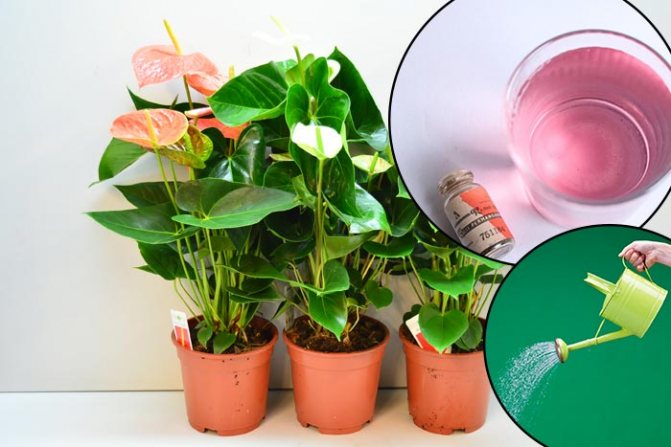

It is not difficult to establish the correct watering of anthurium, you just need to take this process carefully. An exotic flower will thank you with a healthy, bright, attractive look. It will become a decoration of the house and will give the owners the joy of long flowering.
Anthurium or "male happiness" is a wonderful home-grown plant. This flower fits perfectly into any interior. Anthurium has beautiful waxy flowers and brilliantly bright green leaves. In order for a flower to have an excellent appearance, it is necessary to properly care for it. Anthurium is considered an unpretentious plant, however, some recommendations should be taken into account. An important component of care is proper watering. How to water anthurium at home so that it looks beautiful is collected in this article.
Read also Shelf life of seeds flowers
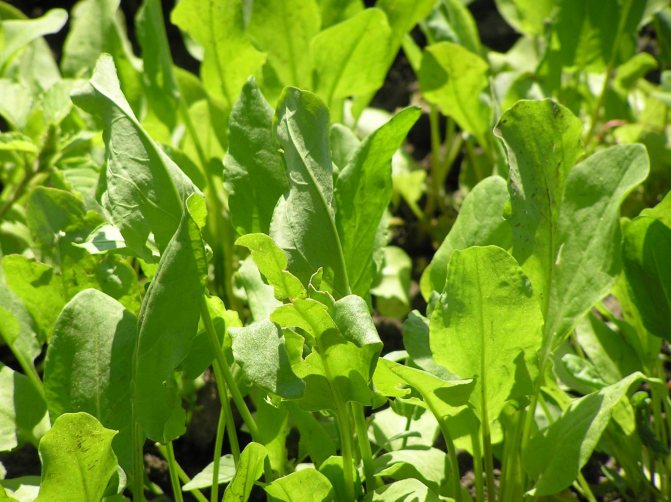

On a note
The recommendations given in the article regarding watering and humidifying the air refer mainly to André anthurium hybrids, since they are most common in our country. As for the Scherzer anthurium, it needs more moisture, including when spraying the leaves. Crystal anthurium, releasing aerial roots, must be watered very carefully, and the roots should be moistened with a spray bottle. They can be rooted using peat.
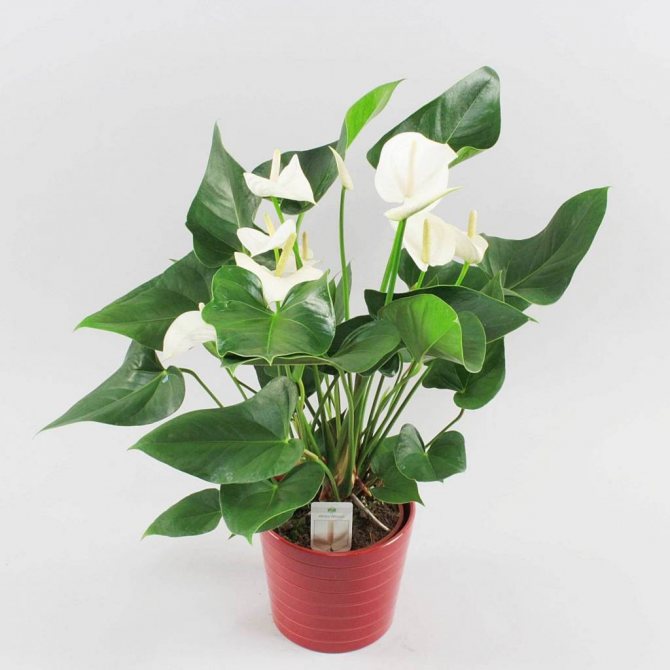

In the spring-summer period, anthuriums should be fed with complex fertilizer for decorative flowering plants every two weeks. Experienced growers recommend halving its concentration.
Anthuriums can be propagated not only by "children", but also by stem cuttings. Seed propagation is usually very troublesome and ineffective.
Diseases arising from improper watering
As mentioned above, anthurium does not like overflowing water. From this, the root system begins to rot, and with it all the other parts of the flower. Leaves suffer the most in anthurium, since they constitute the bulk of the flower.
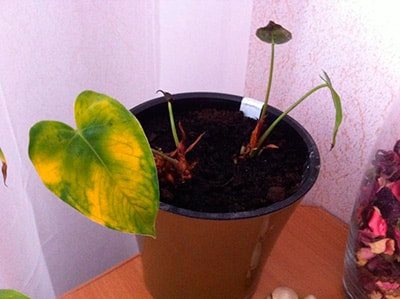

Leaves may darken and become dark spots. This happens to them due to too frequent and abundant watering.- When can the leaves become covered with white dots? This most often happens if the flower is watered with cold and hard water.
- If you endlessly fill the flower with water, it is almost impossible to avoid fungal diseases. They affect both the soil around the plant and the plant itself. There are several anthurium diseases. Let's briefly consider some of them.
- Powdery mildew - occurs with increased soil and air humidity. Expressed as a white coat on the surface of the plant. It can be treated with antifungal agents.
- Sooty mushrooms - are a consequence of the colonization of the leaves by aphids. They live just on the waste products of the latter. They are dangerous for the flower in that they block any possibility of growth and development for the plant. All parts of the plant are affected. If it was not possible to prevent the process, then it can be stopped by washing the flower with a solution of potassium soap. Complete removal of the affected areas will help to completely get rid of the soot fungus.
- Rust - occurs on the stems and leaves of anthurium, suffering from drought. Expressed by the appearance of dark brown areas on the leaf. Gradually, completely darkened leaves begin to fall off. Rubbing with a Bordeaux mixture and the complete elimination of infected leaves will come to the rescue.
Air humidification
Anthuriums need humid air no less than watering. With insufficient air humidity and an excessive amount of light, the leaves of anthuriums begin to curl up into tubes. It is advisable to purchase a humidifier or place the plants on trays with expanded clay or sand, which should be periodically moistened.
You can also spray the plants with a spray bottle. In this case, it is necessary to ensure that water does not fall on the inflorescences. Otherwise, they will become covered with spots and quickly fall off. It is the air around the plants that needs to be sprayed: it should be very fine water dust, suspension.
From time to time, you need to gently wipe the plant leaves with a damp cloth or sponge. You can wash it under the shower, but, again, do it carefully so as not to wet the inflorescences. It is advisable to remove excess water from the leaves with a paper napkin.
What kind of soil is needed for anthurium?
To maintain this plant, you will need loose, well-draining soil that can freely pass water and air to the roots of the plant. A mixture of peat and deciduous soil with coarse-grained sand, taken in equal parts, is well suited for this. Charcoal and some chopped bark of a coniferous tree (spruce, pine, etc.) should be added to the soil prepared in this way. The video below tells about the secrets of the care and reproduction of anthurium:
How to water efficiently?
If you prefer to use the bottom method of watering the flower, through the pallet, then it is best to combine it with the top method. This is required because drainage does not always allow water to reach the topsoil.
Watering requires the use of soft and settled water. To make the water softer, you need to use citric acid or lemon juice.
With insufficient watering, the development of anthurium slows down and its leaves fall.
The lower leaves dry and then curl up. They begin to turn yellow and brown spots appear on the tips. The flowers begin to wither very quickly.
Excess moisture can also be determined quite simply for several reasons:
- The appearance of plaque on the petals.
- The root system becomes dehydrated and a brown tint appears.
- You can smell an unpleasant smell coming from the ground.
- Soft rotten areas appear on the flower.
- In addition, excessive moisture leads to slow growth of the flower.
For abundant flowering, it is necessary to take care of the anthurium at home correctly. Anthurium prefers bright light, only the pot with the plant must be removed from direct sunlight. In winter, for abundant flowering, it is optimal to create additional lighting. It is best to put the pot with anthurium on the western window.
To keep anthurium, the temperature in the room should be between 20 and 25 degrees. Sharp temperature changes have an extremely detrimental effect on the general state of the anthurium.
In the spring and summer, the plant should be fed once every two weeks. Fertilizers for aroid are well suited for this. It is also recommended sometimes to make foliar dressing at the same time as watering.
The nuances of watering after transplant
According to the rules, before placing a flower in a new pot, it is watered abundantly, then water should be added again - already to a new substrate.
After what time is watered for the first time
When transplanting, the soil is saturated with moisture to the limit, so the next scheduled watering is carried out no earlier than in 5-7 days. It is best to check how dry the soil is before watering with a dry stick or a special indicator.
Attention! If during transplantation a large number of roots (dry, broken, rotten) were removed, the new substrate is moistened to a minimum or completely dry, saturating the drainage with moisture.
What to water
Since there are enough nutrients in the new substrate, they are watered only with water, without any additives in the form of fertilizers. But it is permissible to add a few drops of a stimulant to the water so that the plant can more easily endure the shock and quickly return to normal development.
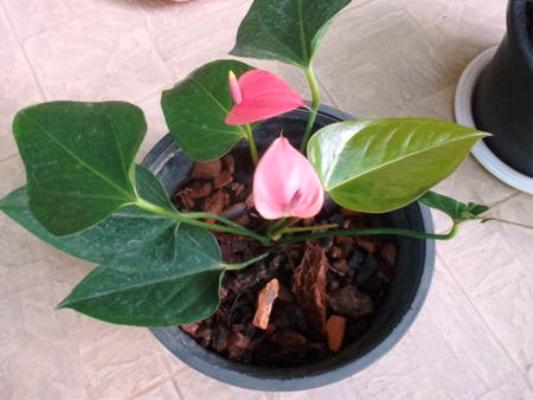

General information
Plants of the genus Anthurium come from the tropical rainforests of Central and South America. This determines their needs for watering and other conditions. They appeared in Europe only at the end of the 19th century. The first specimen was planted in England, in the Royal Botanic Gardens. Three out of several hundred species deserve special love of flower growers. These are anthuriums Andre (Anthurium andraeanum), crystal (Anthurium crystallinum) and Scherzer (Anthurium scherzerianum). In the homes of some flower lovers, you can also find climbing anthurium (scandens). This is a vine that requires a lot of space, so for the most part it is grown in greenhouses and botanical gardens.
Anthuriums are highly decorative. The bracts of plants are usually brightly colored. Flowers tolerate cutting well and can stand in water for up to a month without losing their appearance. They are often used in landscaping and decoration of not only residential but also office premises.
Caring for different types of anthuriums has a lot in common, but may differ in details.
What can mistakes lead to?
Improper watering of the plant can lead to negative consequences. For example, too frequent watering will cause the roots of the plant to rot.If you rarely water a flower at all, then soon it will begin to fade and dry out. As a result of improper care, male happiness will cease to grow and delight with its beautiful flowers.
Correct watering of anthurium is the key to its health and beauty. It is not difficult to establish the correct watering process - the main thing is to adhere to all the above recommendations.
Watering depending on the species
Watering the plant at home should be correct, especially during the active growth period (in the spring and autumn). It is during these seasons that anthurium needs more moisture. But only, it is recommended to organize a competent watering regime so as not to overwhelm the home beauty. Otherwise, it can lead to rotting of the root system. To prevent excessive moisture, you need to reduce the frequency of watering.
Professionals advise using drainage in a flowerpot to quickly get rid of excess moisture.
A species such as Anthurium Climbing must be watered evenly all year round, and it also needs to be sprayed from time to time from a spray bottle. Anthurium Scherzer should be watered abundantly during the warm season. In winter, watering should be kept to a minimum. Anthurium Crystal should be moisturized carefully throughout the year. The plant responds positively to humid air.
Water quality and properties
Anthurium reacts to the state and properties of the water that is used to irrigate it. For example, if the concentration of calcium salts in the water is increased, it is too cold or hot, then watering can harm the plant. Young anthuriums are especially susceptible to these indicators. They react with yellowing and falling leaves, as well as a general deterioration in the condition. For watering anthurium, warm water at room temperature with a neutral pH level without bleach and heavy metals is suitable. These elements have the property of settling on the roots of the plant and disrupting its normal nutrition and growth.
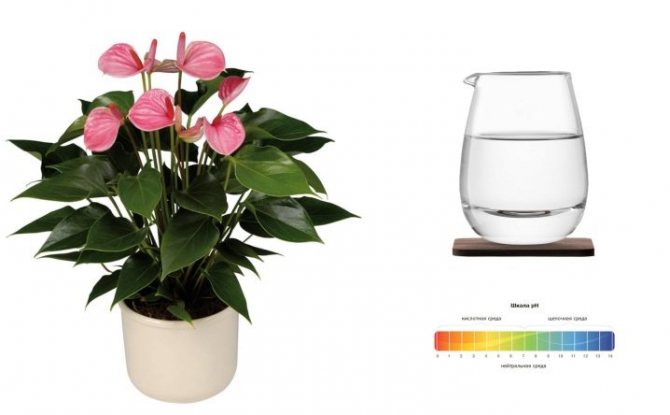

You can also water anthurium with rainwater. To do this, use the water that has accumulated after prolonged showers. Intermittent rains carry harmful substances, especially in industrial areas. There are several ways to improve the quality of your tap water.
- Freezing. The procedure is best done outdoors in winter. Water is poured into a metal container and exposed to frost. After half of the liquid is frozen, the remaining water is drained, and the ice is melted and used for watering. Similarly, you can prepare water by freezing water in a plastic bottle in a freezer.
- Defending. This is one of the easiest ways to prepare water for anthurium. It only takes 1 day to prepare it. The next day, the water softens as the salts settle to the bottom. Only the upper and middle layers of water should be used, and the part where salts have accumulated should be poured out.
- Boiling. This method also makes the water softer. To prepare water for irrigation, it should be boiled and cooled to room temperature. During the boiling process, it is possible to get rid of lime, which settles on the walls of the dishes.
For information on how to properly water anthurium, see the next video.
Decorative anthurium has a reputation for being an unpretentious plant, but to maintain its presentable appearance, you need to follow simple but mandatory rules of care. It is especially important to know how to water anthurium, since it is precisely miscalculations in watering that are the most common cause of disease and death of a flower.
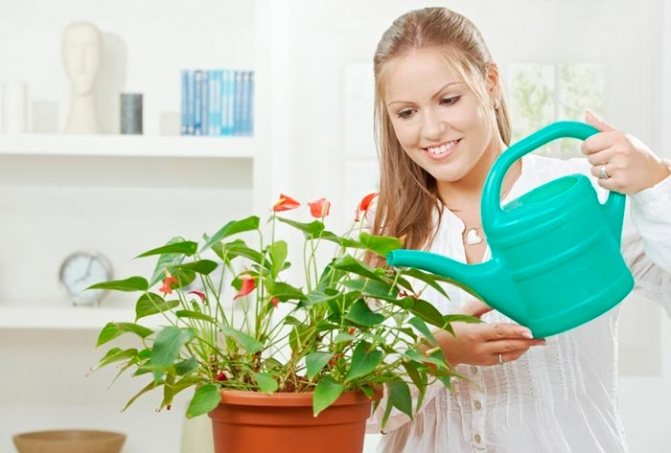

Features of watering after purchase
Shipping soil used to fill containers for selling flowers, incl. anthuriums, has its own moisturizing characteristics, which are difficult to implement at home. In order not to harm the newly purchased anthurium, transplant it immediately. Watering the transplanted plant is carried out as described above (after a conventional transplant).
Note! Although the frequency of watering after transplanting is reduced, this does not apply to wetting the aerial parts of the plant. They are sprayed in the usual manner.
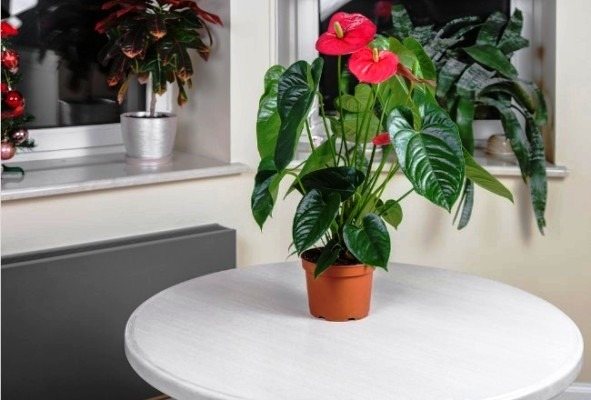

Adjusting the amount of water
When watering, you need to take into account the pot in which the plant is located, and also know the quality of drainage. If the anthurium is contained in a plastic container, where there is excellent drainage, then less water will be required for it. A flower in an earthenware pot needs more moisture, since the clay absorbs moisture well enough.
Indoor anthurium must be watered abundantly during the intensive growth period. During hibernation, much less water is needed. The plant should be watered until water appears in the pan. After 30 minutes, flush out all the liquid from the pan to prevent root rot. Experts agree that epiphytic flowers, in which the roots protrude outward. It is required to frequently spray the root system of such plants. You also need to know that such varieties are extremely demanding on high levels of humidity.
Anthurium, or male happiness - a description of the flower
Evergreen beautifully blooming, less often decorative leafy anthurium (anthurium) represents the Aroid family (Aronnikovs). According to various sources, the species diversity ranges from 500 to a thousand species, most of them are epiphytes. Plants in their natural environment are common in the humid tropics and subtropics, and therefore love warmth and moisture. The shape and size of the flower leaves are determined by the species, they can be whole or dissected, large or small, with prominent color veins or with a kind of ornament.
The cob-shaped flowers are supplied with an inflorescence, often large leaf, which makes the plant especially attractive. The color of the bracts in various species varies from various shades of white to saturated red, purple, yellow, can be monochromatic, rolling, variegated.
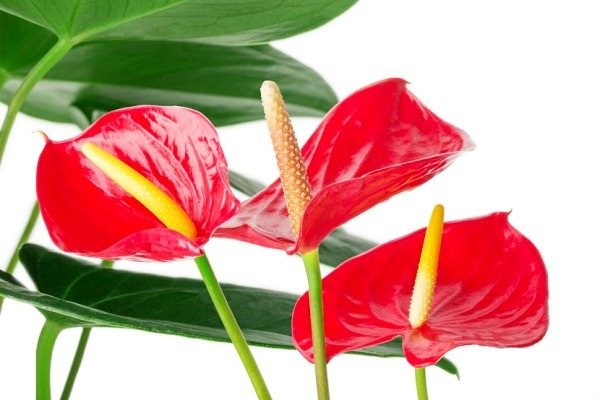

Anthurium owes its second name - male happiness - to a cob-shaped inflorescence, in which a phallic symbol was once seen. Also, the plant is often called a flower-tail, a flamingo, an artist's palette and even a pig's tail or a devil's finger.
Watering rules
Florists recommend watering an indoor flower in the morning to reduce the risk of moisture stagnation. Because, if you moisten the plant in the evening, then there is a high probability of stagnation of water in the pot. To test the soil for moisture, you can place your finger in the soil a few centimeters, if the soil is wet, therefore, it is not worth watering.
To determine how often to water "male happiness", it is necessary to take into account the indoor temperature and lighting. In a warm room and in good lighting, the flower needs increased moisture.
Before moisturizing the soil, you need to take into account the age of the anthurium and how many leaves are on the plant. Young specimens need to be watered frequently, as they require constantly moist soil.
Just do not overdo it, the soil should be slightly moistened. When the plant grows up a little, it must be watered after the top layer of the soil has dried. Also, if the plant does not have a large number of leaves, then it needs less water. A large root system requires more water.
Watering depending on the type
In addition to seasonal characteristics, there are also individual species characteristics of some anthuriums, which must also be taken into account when watering. It is worth paying attention to the following types:
- climbing anthurium does not have a dormant period, so it needs year-round watering; in addition, constant spraying of aerial parts is useful to him: leaves, stems and aerial roots;
- when growing Scherzer's anthurium, it is imperative to reduce watering in winter and completely abandon spraying before the onset of heat;
- crystal anthurium prefers uniform watering at any time of the year;
- anthurium Andre during growth needs regular watering, which is reduced by winter; in addition, it must be sprayed daily;
- Linden's anthurium is watered exclusively through the pallet;
- Hooker's anthurium during the period of active growth is watered often and abundantly, but moisture stagnation is not allowed; during the rest of the plant, watering must be reduced;
- Wendlinger's anthurium is watered according to generally accepted rules, with the exception of spraying - it is produced up to 2 times a day in summer and 1 time in 3 days in winter, while the flowers are protected from moisture;
- Anthurium Veicha also prefers a standard watering scheme in summer and moderate watering in winter; in addition, in the warm period, the plant is sprayed every day and once every 2 days in winter.
How often to water the flower "male happiness"
How often to water the anthurium so that it does not dry out, and at the same time, to avoid root rot is a question that often worries the happy owners of this representative of the flora. Indeed, in most cases, the death of this type of flowers occurs due to excessive watering. It is important to adhere to the golden rule, which is that underfilling is better than overfilling. Rare but abundant watering can be more detrimental than prolonged drying.
Watering should be done after the substrate has dried about half of the flowerpot. To determine the degree of dryness of the soil, you can weigh the containers with a flower in your hand: if, after lifting the pot, you feel that it is light enough - the flower can be watered, if there is heaviness - it is better to postpone watering for a couple of days.
Top dressing when watering
If "male happiness" is fed with ready-made fertilizers (from the series "Kemira", "Feritka", Agricola, etc.), they are dissolved in water for irrigation in the recommended doses.
Florists who have devoted their lives to cultivating a flamingo flower recommend alternating top dressing with mineral complexes at the root with foliar. A reduced portion of complex fertilizers is included in the spray water. This allows nutrients to quickly penetrate the tissues of leaves, stems, peduncles.
Advice! After 20-30 minutes. after feeding, the leaves are wiped with a slightly damp cloth so that no "salty" traces remain.
Is it possible not to use top dressing?
The plant can grow well without fertilization as long as the soil is rich in nutrients. But over time, food is consumed, and the plant begins to lack nutrients, which affects the appearance and flowering. Therefore, it will not be possible to do without fertilizers at all.
There is a huge variety of preparations for anthurium fertilization on the market. You can use only organic matter or ready-made complex preparations, you can stop at home-made dressings. It is up to you to decide which fertilizer to use. Do not forget to feed your anthurium and in return you will receive a beautiful flowering plant.
If you find an error, please select a piece of text and press Ctrl + Enter.
Purchase of drugs
When buying, you need to pay attention to the intended purpose and in what form the fertilizer. In granules, the fertilizer has a longer duration of action, in liquid form it is quickly absorbed, but it lasts for a short time. Here are the most popular drugs:
- Azalea (price from 123 rubles in Moscow), Yantarin (price 78 rubles);
- "FORTE" for indoor plants (price 100 rubles);
- "Kemira" (79 rubles per 1 kg.), Spray for leaves "FORTE" in Moscow costs 260 rubles;
- "Agricola for indoor plants" (20 rubles).

